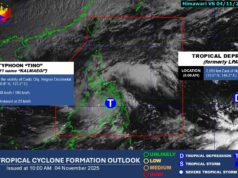Central bank flags even faster August inflation

By Melissa Luz T. Lopez, Senior Reporter
THE OVERALL INCREASE in prices of widely used goods likely clock in around 5.9% in August — marking a fresh multiyear high — the Bangko Sentral ng Pilipinas (BSP) said in a statement on Friday, noting that food and utility costs maintained their ascent.
In a statement, the BSP’s Department of Economic Research gave a 5.5-6.2% estimate range, implying that prices have climbed faster than July’s 5.7% reading and the 2.6% reading seen in August 2017.
The range is higher than the central bank’s 5.1-5.8% estimate for July inflation.
This would be in line with BSP Governor Nestor A. Espenilla, Jr.’s signals that inflation will clock in faster this month, though not beyond six percent.
At the same time, the BSP department noted that “[t]he central forecast implies a slight deceleration of the month-on-month inflation”.
The Philippine Statistics Authority (PSA) is scheduled to report August inflation data on Wednesday, Sept. 5.
This is the first time that the BSP gave a specific figure for headline inflation ahead of the official PSA data. If realized, this will mark a fresh multiyear high for inflation using 2012 prices as base.
“Higher price of rice and key food items due to weather disturbances and supply disruptions, increase in gasoline and LPG prices, and slight upward adjustment in electricity rates in Meralco-serviced areas contributed to upward price pressures in August,” the central bank said.
Oil companies introduced four waves of pump price increases last month to reflect movements in global crude prices. Year-to-date prices saw a net increase of P6.90 per liter for gasoline and P7.15/liter for diesel as of Aug. 28, according to the Department of Energy’s oil monitor.
Manila Electric Co., the biggest power distributor in the country, also announced a P0.0265 increase per kilowatt-hour for electricity bills due to a higher generation charge.
On the flipside, lower diesel and kerosene prices, as well as a “modestly appreciated peso” likely helped ease price pressures for the month.
The peso has been trading weaker than P53 versus the dollar in recent weeks, even as it briefly touched the P52 level earlier this month.
Mr. Espenilla has been saying in recent weeks that inflation will peak by August or September before gradually easing back to the 2-4% target range by 2019.
Prices of widely-used goods and services have surged by an average of 4.5% as of end-July, while full-year inflation is expected at 4.9%. The central bank has blamed supply-side factors such as surging global oil prices, additional excise taxes on certain products which took effect this year, as well as weather disturbances that disrupted food supply as the key reasons behind July price spike.
In response, the BSP fired off its strongest response in a decade by raising interest rates by 50 basis points (bp) in its Aug. 9 meeting. This pushed yields 100bp higher year to date, with the benchmark yields now at 3.5-4.5%.
“The BSP will remain watchful of economic and financial developments that could affect the inflation outlook and will closely monitor inflation expectations and emergence of further second-round effects ahead of the September 2018 Monetary Board policy meeting,” the central bank added.
Mr. Espenilla said in a forum earlier this week that the BSP has “kept the door open” for succeeding rate hikes in order to ease inflation pressures, noting that the economy can still accommodate further monetary policy tightening while growing at a rapid pace.
Inflation momentum has been “slowing” in recent months, although prices will likely remain “elevated” until yearend, the BSP chief added.



